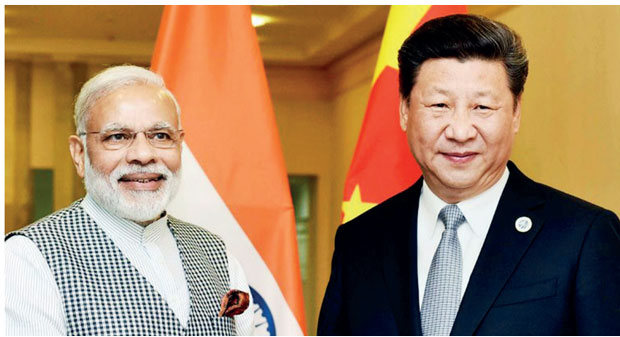15 Jun 2017 - {{hitsCtrl.values.hits}}

 After three years of uncertainty surrounding China’s ambitious Belt and Road Initiative (BRI), the highly anticipated Belt and Road Forum (BRF) was finally held in May 2017 in Beijing. But India, Beijing’s most populous neighbour, was conspicuous in its absence.
After three years of uncertainty surrounding China’s ambitious Belt and Road Initiative (BRI), the highly anticipated Belt and Road Forum (BRF) was finally held in May 2017 in Beijing. But India, Beijing’s most populous neighbour, was conspicuous in its absence.
Despite earlier concerns over a lukewarm response particularly from the West, the BRF won global recognition with 29 heads of state, 1500 delegates from over 130 countries and some 70 international organisations in attendance. Even the United States, which had earlier signalled its wariness towards the initiative, sent a high-profile delegation led by National Security Council Senior Director Asia Matthew Pottinge.
Chinese Ambassador to India Luo Zhaohui revealed China’s eagerness to secure high-level Indian participation when he offered to consider renaming the China–Pakistan Economic Corridor (CPEC), an element of BRI that runs through the disputed territory of Pakistan-occupied Kashmir. The United States’ last minute u-turn also put pressure on India. Yet India was undecided about even participating in the summit until the day before it was due to start, when an External Affairs Ministry spokesperson announced India’s boycott.
This sudden shift in India’s position from non-endorsement to outright opposition has stoked much speculation over Delhi’s calculations behind the move. India, which has repeatedly expressed its apprehension about the CPEC, reiterated its concerns over the issue of national and territorial sovereignty. Going a step further, India also bluntly warned of the danger of the ‘unsustainable debt burden’ that the BRI would bring on those countries involved with Chinese financing of ‘white elephants’. The US $1.4 billion Colombo Port City project in Sri Lanka is a prominent example, having left the country with a debt burden of US $ 8 billion to China.
Such an indignant response by India is hardly surprising. Souring ties between India and China have made front page headlines for quite some time now. China’s opposition to India’s membership of the Nuclear Suppliers Group, its blocking of India’s bid at the UN to blacklist the leader of Islamic fundamentalist group Jaish-e-Mohammad and India’s intentional provocation with the Dalai Lama’s visit to Arunachal Pradesh in April disrupted the earlier bonhomie between Indian Prime Minister Narendra Modi and Chinese President Xi Jinping.
The first strategic dialogue between India and China was held in February 2017 amid much anticipation, but the two sides were unable to significantly narrow their divide on certain ‘friction points’. India’s decision to skip the BRF is the most recent swing of the pendulum.
India is uneasy about Chinese designs for the region and how this challenges India’s own ‘neighbourhood first’ approach. China’s BRI diplomacy is an attack on India’s conception of a multipolar Asia. Under its own ‘Act East’ framework, the India–Myanmar–Thailand trilateral highway project is an example of India’s interest in strengthening regional connectivity as a precursor to greater economic integration with the Mekong sub-region.
Concurrently, India’s ‘Go West’ strategy aims to support infrastructure development in Iran’s Chabahar Port, as well as the more ambitious goal of the International North–South Transport Corridor — expected to be ‘30 percent cheaper and 40 percent shorter’ than the current route from India to Russia.
For India, the BRI exemplifies a unilateral instrument for China to further its hegemony over partner countries, with little respect for principles of sustainable and inclusive development. Questions have been also raised over the supposed economic benefits — Chinese investment in African nations such as Djibouti highlights the risk of financing projects that are economically unviable to begin with.
Yet, India’s absence from the BRF leaves it without an opportunity to voice the legitimate concerns it has regarding the BRI. India also stands to lose if it fails to translate its criticism of Chinese intentions into more constructive means. Participation in the BRF might have been an important first step.
India’s absence at the BRF does not mean that its boycott is permanent. India’s spokesperson hinted at the possibility of joining if China engages ‘in a meaningful dialogue on its connectivity initiative’. Responding to this statement, a Chinese Foreign Ministry spokesperson questioned India’s definition of ‘a meaningful dialogue’, but noted that India would be still welcome to join the initiative.
India’s decision may not overshadow its broader bilateral relations with China. But the recent announcement of the Asia–Africa Growth Corridor, an India–Japan joint effort to support development in Africa, suggests that India has its own agenda in mind. The 21st century’s great game is about to get even more complicated and unpredictable.
(East Asia Forum)
(Soyen Park, a recent PhD graduate of Korea University, currently resides in New Delhi, India and carries out independent research on the Indian economy. Ramandeep Singh, a recent graduate of the University of Cambridge, works on contemporary issues in international trade and investment)
08 Jan 2025 7 minute ago
07 Jan 2025 7 hours ago
07 Jan 2025 7 hours ago
07 Jan 2025 8 hours ago
07 Jan 2025 07 Jan 2025